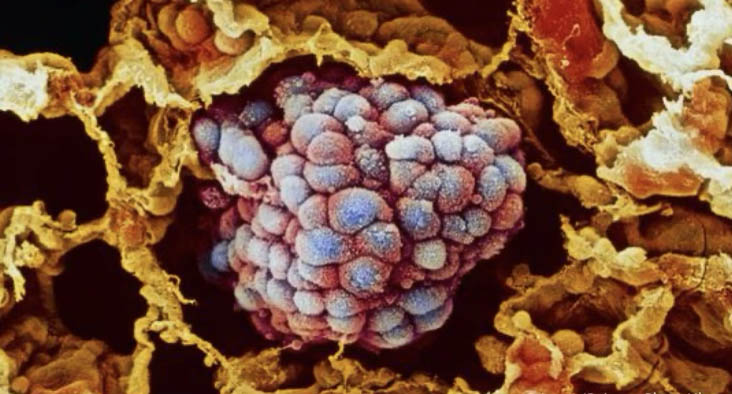
By: Prof. Dr. Seyed Saeid Zamanieh Shahri, MD and Prof. Dr. Sonia Sayyedalhosseini, MD
Cervical cancer:
Since the uterus has a very important function, it can also be affected by various types of diseases, including cancer. After breast cancer, uterine and ovarian cancer are among the most common types of cancer among women. In this article, we intend to discuss the aspects of this disease. Cervical cancer occurs when the cells of the cervix become abnormal and multiply rapidly. The cervix is the part of the uterus that is located between the vagina and the body of the uterus. Failure to diagnose or treat this cancer in time will definitely threaten the person’s life.
Cervical cancer was the leading cause of death in women in the past, but it is currently the easiest female cancer to prevent. Routine Pap smear tests and HPV vaccines and HPV tests have made it easy to prevent cervical cancer. Awareness of the symptoms of cervical cancer helps with early diagnosis and timely treatment.
Anatomy of the uterus: The uterus is a flat, pear-shaped organ consisting of: an upper, triangular part and a lower, cylindrical part.

In non-pregnant women, the uterus is located in the true pelvic cavity and between the bladder and rectum.
Uterus consists of three parts:
1. Fundus, the round, dome-shaped part of the uterus located at the top of the uterus.
2. Body of the uterus
3. Isthmus (isthmus) is the part of the uterus located between the internal opening of the cervix and the endometrial cavity.
The position of the uterus tends to be forward (antroversion). The fundus of the uterus is made up of 90 percent muscle tissue and 10 percent connective tissue. The strongest area in terms of contraction is the fundus. The uterus is the place where the baby grows during pregnancy. The uterus is the size and shape of a hollow, inverted pear that is located in the lower abdomen, between the bladder and rectum, and is connected to the vagina by the cervix. On both sides of the uterus are the 2 ovaries, which contain eggs. The ovaries are connected to the uterus by the fallopian tubes. The uterus has two layers:
The myometrium is the outer layer of muscle tissue and makes up most of the uterus. The endometrium is the inner layer, or lining.
The cervix is the narrow lower part of the uterus, which is located at the entrance to the vagina. Almost all cases of cervical cancer are caused by the human papillomavirus (HPV). These cancers are often caused by sexually transmitted infections. Millions of new infections occur each year.
Function of the uterus: An organ for menstruation, receiving a fertilized egg and storing and nourishing it until birth, supporting and protecting the fetus, contracting during labor, and helping to expel the fetus.
Different types of uterine cancer:
a) Endometrial cancer: Uterine cancers form mainly in the cells lining the wall of the uterus (the cells lining the endometrium). For this reason, most uterine cancers are also called endometrial cancer.
b) Uterine sarcoma: Uterine cancer can rarely form in the muscles surrounding the uterus. This type of cancer is called uterine sarcoma and may have different treatment methods than endometrial cancer.
Staging of uterine cancer: Health professionals use a classification system to describe the extent of uterine cancer. These stages are:
Stage 1: At this stage, the cancer is still inside the uterus and has not spread throughout the body.
Stage 2: The cancer has spread to the uterus and cervix.
Stage 3: The cancer has spread to nearby tissues, such as the pelvis and lymph nodes, in addition to the uterus.
Stage 4: The cancer has spread to the soft tissues of the abdomen or to organs such as the bladder, intestines, liver, and lungs. (Metastasis)
Causes of uterine cancer: Certain factors may increase the risk of developing this cancer.
Estrogen hormone imbalance: One of the most important things that increases the risk of developing uterine cancer is hormonal imbalance. In particular, high levels of a hormone called estrogen increase the risk of developing this cancer even more.
Long-term use of tamoxifen: Factors that can disrupt the balance of estrogen in the body include obesity, diabetes, and hormone replacement therapy (HRT). Long-term use of tamoxifen also increases the risk of developing uterine cancer to some extent.
It is not always possible to prevent uterine cancer; however, things like maintaining a healthy weight and using certain birth control methods for a long time can reduce the risk of developing this disease.
Human papillomavirus (HPV): The human papillomavirus (HPV) causes several types of cervical cancer. Certain types of the human papillomavirus (HPV) cause normal cervical cells to become malignant and abnormal. These cells can take years or even decades to become cancerous.
To be continued ….









